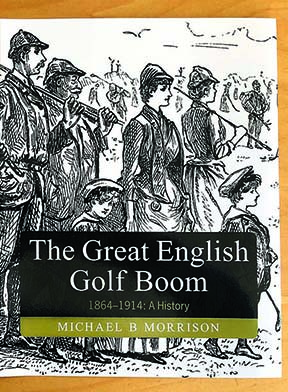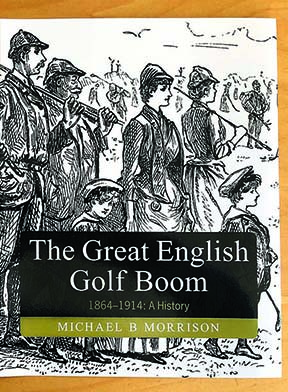
By Michael B. Morrison
320 pages including over 200 illustrations, charts and maps
Self-published, hardback and colour.
Price: £29.50 U.K. post and packing
To order, and for U.S price and postage, email:
Mike.Morrison57@outlook.com
Reviewed by Pete Georgiady (Autumn 2022, The Golf)
In the past few years a very palatable assortment of golf history books have been published. Michael Morrison’s in 2022 certainly fits that bill. The Great English Golf Boom, A History: 1864-1914 traces the rise in popularity of golf in ‘South Britain’ from mid-century to the advent of the Great War. As one pages through it one realizes very quickly the completeness of the story. It is not just a mainline train journey from A to B but an assembly of data based on influential events, social norms, their changes, external stimuli and how the game gave itself momentum. This train makes many stops along its route.
In the beginning Morrison sets the stage with two vital questions: Why did it take golf so long to catch on when the game was centuries old just north of the Tweed; and what caused it to happen? The layout of the book is carefully set out in the author’s prologue with a preview of what each of the nine sections covers. When consuming the chapters, the reader will be submerged in facts and observations on how events and social habits of the day impacted the game.
The largest causal portraits include associated topics such as the rise of the rail system, growth in resort locales and their adoption by a newly spending and traveling Victorian middle class. The gutta percha ball effect, the expanding press attention and spawning of golf and sporting publications are also discussed. Fashion and affordability greatly impacted golf expansion and are treated appropriately.
Additive to the game’s expansion was the adoption of golf by females and formally organized women’s clubs. And who would ever dare ignore the impact of golf apparel especially among distaff golfers. Publications thrived.
The ‘booming,’ as Horace Hutchinson described the game’s advance, created growth in ancillary areas such as course architecture, and books authored by famous amateurs and professionals to be absorbed by the fledgling golf populace. Morrison also hypothesizes how architecture and greenkeeping played a role in the growth. Well laid out and maintained courses gave golfers greater satisfaction in a day’s outing that could easily be frustrating.
Since growth is the central premise, the book is full of numerical references. Census information on courses and number of players is everywhere. The usual images of well-known golfers and golf courses are many but probably outdone by the number of bar charts, histograms, scatter diagrams, tables and maps included. Any reader with a love of golf and penchant toward statistics and analytical calculations will be at home within the historical pretexts. England is the topic but comparisons to similar situations in Scotland are myriad. Canada gets a mention, too.
The best quote appears early at the beginning of chapter 1.
An English young lady, lately returned from a visit to Scotland. She was remarking to her friends at home on the wonderful extension of the game of Golf. “It is played everywhere now,” she said; “it has even spread to Scotland….” (GOLF, 10 July 1891)
Morrison has approached all topics with a historian’s eye along with the heart of a true golfer.
The scope of this volume’s 320 pages not only supports its thesis but Morrison’s work can stand as a highly informative and detailed text book on pretty much a huge swath of golf’s history were there ever an educational course to be taken.
Reviewed by Pete Georgiady

